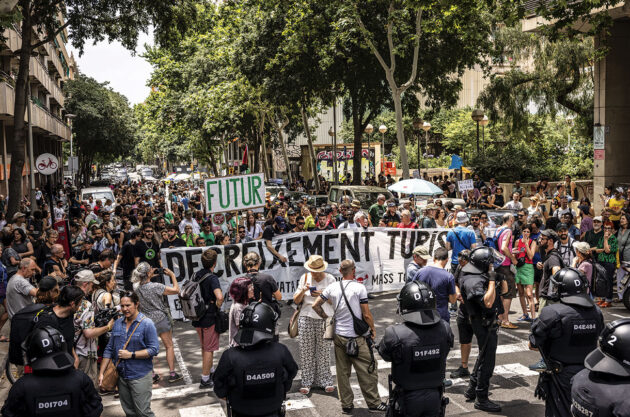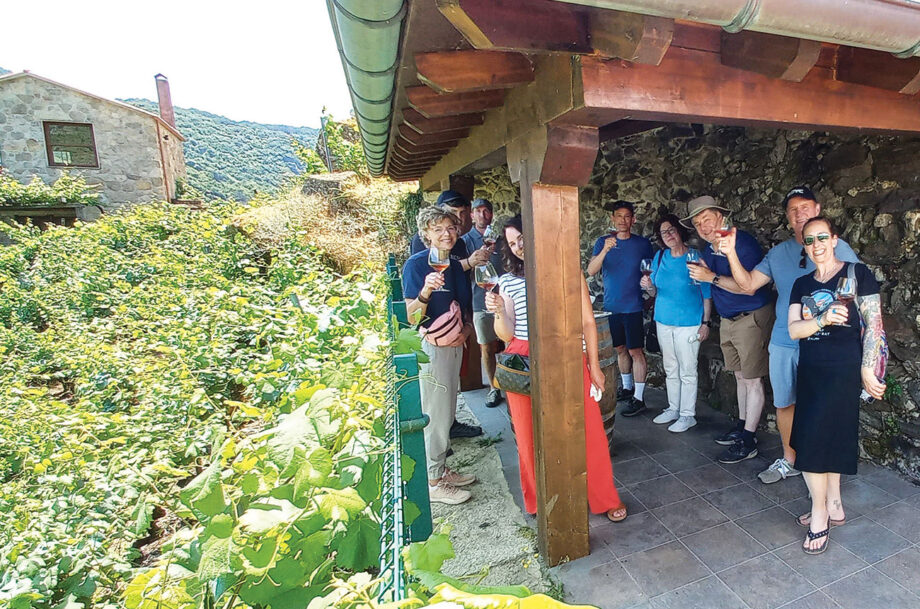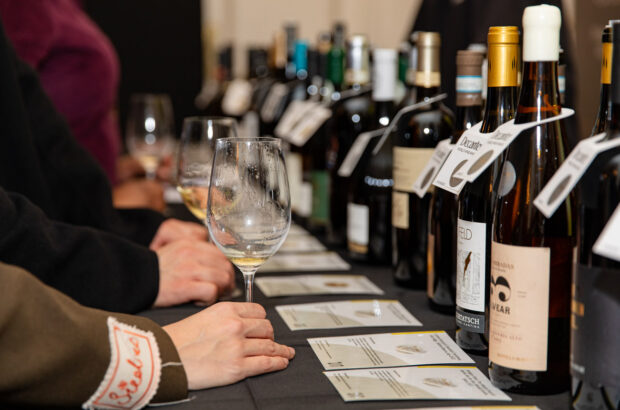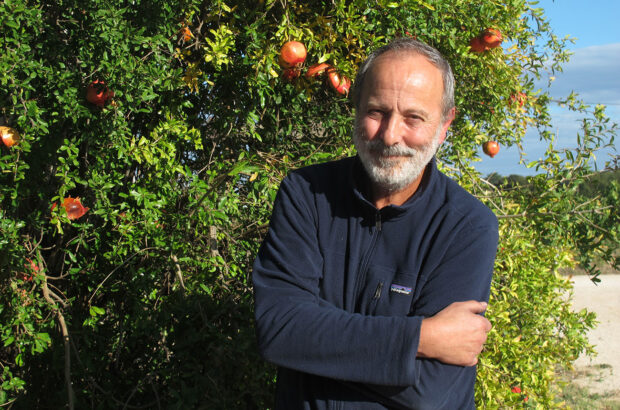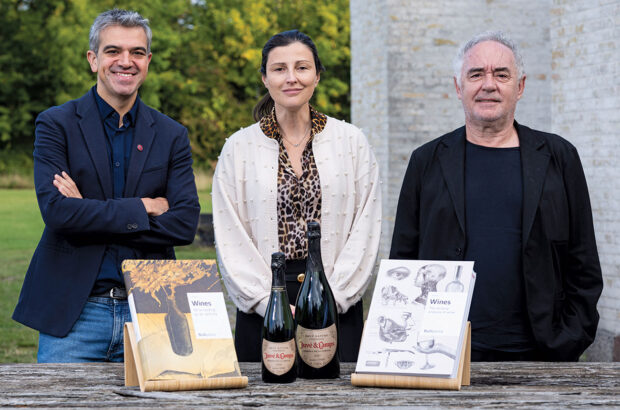The hastily painted graffiti appeared on a well-trafficked street during my yearly visit to A Coruña, in northwest Spain: ‘TOURISTS GO HOME!’
This coastal Galician city receives far fewer tourists than popular holiday destinations such as Barcelona, Ibiza or Benidorm, but even A Coruña – an increasingly popular stop for cruise ships from Germany, the UK and the US – has felt the strain of a rising tide of visitors.
It’s a tension being felt all over Spain. Earlier this summer, simmering frustrations bubbled over as protests broke out across the country.

Overtourism backlash: demonstrators march during a protest called by the ABDT group
(Neighbourhoods Assembly for Tourist Degrowth) in Barcelona, June 2025. Photo credit: ANGEL GARCIA/BLOOMBERG VIA GETTY IMAGES.
Angry locals picketed hotels and berated tourists sitting outside cafés, even spraying them with water pistols. Tourism, which according to official data accounts for more than 12% of Spain’s GDP, is being blamed for a medley of issues including gentrification of city neighbourhoods, higher housing costs and damage to the environment.
Other side of the coin
Despite its very real pitfalls, not everyone is against tourism – at least not in certain forms.
Many of Spain’s wine regions are putting their resources into ‘enoturismo’, or wine tourism. The benefits are compelling – in fact, tackling many of the issues caused by overtourism elsewhere.
Wine tourism redistributes visitors beyond cities into rural areas, helping to ease overcrowding. And it isn’t especially seasonal; there are plenty of opportunities to enjoy wine regions throughout the year.
It also creates economic opportunities in places where they might otherwise be harder to come by – an important countermeasure to the socioeconomic forces that created the so-called ‘España vacía’: large swathes of Spain’s rural interior that became depopulated as people moved away to find employment, particularly during the 1950s and ’60s.
Data reported by tourism organisation Rutas del Vino de España (Wine Routes of Spain) for 2023 estimates that wine tourism brings in more than €100 million a year in visits to wineries and museums alone – not including spending on accommodation, restaurants or tour companies, which is estimated to be in excess of €300 million.
Inland discoveries
With that in mind, Spanish wineries are making moves to attract more wine-loving visitors.
{"content":"PHA+SW4gcG9wdWxhciBob2xpZGF5IGRlc3RpbmF0aW9uIE1hbGxvcmNhLCBtb3JlIGFuZCBtb3JlIHdpbmUgbG92ZXJzIGFyZSBoZWFkaW5nIGlubGFuZCwgZHJpdmVuIGJ5IGEgZ3Jvd2luZyBpbnRlcmVzdCBpbiBsb2NhbCB3aW5lcyBhbmQgdGhlIGRlc2lyZSBmb3IgYW4gYWZmb3JkYWJsZSB3YXkgdG8gZXNjYXBlIHRoZSBjaGFvcyBvZiB0aGUgQmFsZWFyaWMgaXNsYW5k4oCZcyBjb2FzdGxpbmUuPC9wPgo8cD48ZGl2IGNsYXNzPSJhZC1jb250YWluZXIgYWQtY29udGFpbmVyLS1tb2JpbGUiPjxkaXYgaWQ9InBvc3QtaW5saW5lLTUiIGNsYXNzPSJpcGMtYWR2ZXJ0Ij48L2Rpdj48L2Rpdj48YnIgLz4KPGRpdiBpZD0iYXR0YWNobWVudF81NzAwMzUiIHN0eWxlPSJ3aWR0aDogNjQwcHgiIGNsYXNzPSJ3cC1jYXB0aW9uIGFsaWduY2VudGVyIj48aW1nIGZldGNocHJpb3JpdHk9ImhpZ2giIGRlY29kaW5nPSJhc3luYyIgYXJpYS1kZXNjcmliZWRieT0iY2FwdGlvbi1hdHRhY2htZW50LTU3MDAzNSIgY2xhc3M9Imxhenlsb2FkIGJsdXItdXAgc2l6ZS1sYXJnZSB3cC1pbWFnZS01NzAwMzUiIGRhdGEtcHJvY2Vzc2VkIHNyYz0iaHR0cHM6Ly93d3cuZGVjYW50ZXIuY29tLm1hc3Rlci5wdWJsaWMua2V5c3RvbmUtcHJvZC1la3MtZXV3MS5mdXR1cmVwbGMuZW5naW5lZXJpbmcvd3AtY29udGVudC90aGVtZXMvc2ltYmEtdGhlbWUvYXNzZXRzL2ltYWdlcy9wbGFjZWhvbGRlci5wbmciIGRhdGEtc3JjPSJodHRwczovL2tleWFzc2V0cy50aW1laW5jdWsubmV0L2luc3BpcmV3cC9saXZlL3dwLWNvbnRlbnQvdXBsb2Fkcy9zaXRlcy8zNC8yMDI1LzExL3dlYi1ERVMzMTYud2luZV90b3VyaXNtLmRhdl82MTIwX2NyZWRpdF9kYXZpZGVfY2FtZXNhc2NhLTYzMHg0MTcuanBnIiBhbHQ9IkFyYWNlbGkgU2VydmVyYSBSaWJhcywgQm9kZWdhcyBSaWJhcyIgd2lkdGg9IjYzMCIgaGVpZ2h0PSI0MTciIGRhdGEtc2l6ZXM9ImF1dG8iIGRhdGEtc3Jjc2V0PSJodHRwczovL2tleWFzc2V0cy50aW1laW5jdWsubmV0L2luc3BpcmV3cC9saXZlL3dwLWNvbnRlbnQvdXBsb2Fkcy9zaXRlcy8zNC8yMDI1LzExL3dlYi1ERVMzMTYud2luZV90b3VyaXNtLmRhdl82MTIwX2NyZWRpdF9kYXZpZGVfY2FtZXNhc2NhLTYzMHg0MTcuanBnIDYzMHcsIGh0dHBzOi8va2V5YXNzZXRzLnRpbWVpbmN1ay5uZXQvaW5zcGlyZXdwL2xpdmUvd3AtY29udGVudC91cGxvYWRzL3NpdGVzLzM0LzIwMjUvMTEvd2ViLURFUzMxNi53aW5lX3RvdXJpc20uZGF2XzYxMjBfY3JlZGl0X2RhdmlkZV9jYW1lc2FzY2EtMzAweDE5OC5qcGcgMzAwdywgaHR0cHM6Ly9rZXlhc3NldHMudGltZWluY3VrLm5ldC9pbnNwaXJld3AvbGl2ZS93cC1jb250ZW50L3VwbG9hZHMvc2l0ZXMvMzQvMjAyNS8xMS93ZWItREVTMzE2LndpbmVfdG91cmlzbS5kYXZfNjEyMF9jcmVkaXRfZGF2aWRlX2NhbWVzYXNjYS0xMzV4ODkuanBnIDEzNXcsIGh0dHBzOi8va2V5YXNzZXRzLnRpbWVpbmN1ay5uZXQvaW5zcGlyZXdwL2xpdmUvd3AtY29udGVudC91cGxvYWRzL3NpdGVzLzM0LzIwMjUvMTEvd2ViLURFUzMxNi53aW5lX3RvdXJpc20uZGF2XzYxMjBfY3JlZGl0X2RhdmlkZV9jYW1lc2FzY2EtMzIweDIxMi5qcGcgMzIwdywgaHR0cHM6Ly9rZXlhc3NldHMudGltZWluY3VrLm5ldC9pbnNwaXJld3AvbGl2ZS93cC1jb250ZW50L3VwbG9hZHMvc2l0ZXMvMzQvMjAyNS8xMS93ZWItREVTMzE2LndpbmVfdG91cmlzbS5kYXZfNjEyMF9jcmVkaXRfZGF2aWRlX2NhbWVzYXNjYS02MjB4NDEwLmpwZyA2MjB3LCBodHRwczovL2tleWFzc2V0cy50aW1laW5jdWsubmV0L2luc3BpcmV3cC9saXZlL3dwLWNvbnRlbnQvdXBsb2Fkcy9zaXRlcy8zNC8yMDI1LzExL3dlYi1ERVMzMTYud2luZV90b3VyaXNtLmRhdl82MTIwX2NyZWRpdF9kYXZpZGVfY2FtZXNhc2NhLTkyMHg2MDkuanBnIDkyMHcsIGh0dHBzOi8va2V5YXNzZXRzLnRpbWVpbmN1ay5uZXQvaW5zcGlyZXdwL2xpdmUvd3AtY29udGVudC91cGxvYWRzL3NpdGVzLzM0LzIwMjUvMTEvd2ViLURFUzMxNi53aW5lX3RvdXJpc20uZGF2XzYxMjBfY3JlZGl0X2RhdmlkZV9jYW1lc2FzY2EtMTIyMHg4MDcuanBnIDEyMjB3LCBodHRwczovL2tleWFzc2V0cy50aW1laW5jdWsubmV0L2luc3BpcmV3cC9saXZlL3dwLWNvbnRlbnQvdXBsb2Fkcy9zaXRlcy8zNC8yMDI1LzExL3dlYi1ERVMzMTYud2luZV90b3VyaXNtLmRhdl82MTIwX2NyZWRpdF9kYXZpZGVfY2FtZXNhc2NhLmpwZyAxMzAwdyIgc2l6ZXM9IihtYXgtd2lkdGg6IDYzMHB4KSAxMDB2dywgNjMwcHgiIC8+PHAgaWQ9ImNhcHRpb24tYXR0YWNobWVudC01NzAwMzUiIGNsYXNzPSJ3cC1jYXB0aW9uLXRleHQiPkFyYWNlbGkgU2VydmVyYSBSaWJhcywgb2YgQm9kZWdhcyBSaWJhcy4gUGhvdG8gY3JlZGl0OiBEYXZpZGUgQ2FtZXNhc2NhLjwvcD48L2Rpdj48L3A+CjxwPiYjODIxNjtDdXJyZW50bHksIGJldHdlZW4gODUlIGFuZCA5NSUgb2Ygb3VyIHZpc2l0b3JzIGFyZSBpbnRlcm5hdGlvbmFsLCYjODIxNzsgc2F5cyBBcmFjZWxpIFNlcnZlcmEgUmliYXMsIDEwdGgtZ2VuZXJhdGlvbiB3aW5lbWFrZXIgYXQgQm9kZWdhcyBSaWJhcyBpbiBNYWxsb3JjYS4gJiM4MjE2O1RoZXnigJlyZSBsb29raW5nIGZvciBhdXRoZW50aWNpdHkgYW5kIGN1bHR1cmFsIGV4cGVyaWVuY2VzIHRoYXQgYWxsb3cgdGhlbSB0byB0cnVseSB1bmRlcnN0YW5kIHRoZSBwbGFjZSB0aGV54oCZcmUgdmlzaXRpbmcuJiM4MjE3OzwvcD4KPHA+QXQgaGVyIHdpbmVyeSBuZWFyIEJpbmlzc2FsZW0sIFJpYmFzIG9mZmVycyBsaW1pdGVkIHRvdXJzIHRvIDE2IHBlb3BsZSBwZXIgZ3JvdXAgdG8gcHJlc2VydmUgYW4gaW50aW1hdGUgZmVlbC4gT3RoZXJzLCBsaWtlIELDoHJiYXJhIE1lc3F1aWRhIE1vcmEgYXQgUG9ycmVyZXMgaW4gdGhlIGlzbGFuZOKAmXMgY2VudHJlLCBob2xkIGphenogY29uY2VydHMgYXQgdGhlIHdpbmVyeSBvciBob3N0IGx1bmNoZXMgaW4gdGhlIHZpbmV5YXJkLjwvcD4KPGRpdiBpZD0iYXR0YWNobWVudF81NzAwMzciIHN0eWxlPSJ3aWR0aDogNjQwcHgiIGNsYXNzPSJ3cC1jYXB0aW9uIGFsaWduY2VudGVyIj48aW1nIGRlY29kaW5nPSJhc3luYyIgYXJpYS1kZXNjcmliZWRieT0iY2FwdGlvbi1hdHRhY2htZW50LTU3MDAzNyIgY2xhc3M9Imxhenlsb2FkIGJsdXItdXAgc2l6ZS1sYXJnZSB3cC1pbWFnZS01NzAwMzciIGRhdGEtcHJvY2Vzc2VkIHNyYz0iaHR0cHM6Ly93d3cuZGVjYW50ZXIuY29tLm1hc3Rlci5wdWJsaWMua2V5c3RvbmUtcHJvZC1la3MtZXV3MS5mdXR1cmVwbGMuZW5naW5lZXJpbmcvd3AtY29udGVudC90aGVtZXMvc2ltYmEtdGhlbWUvYXNzZXRzL2ltYWdlcy9wbGFjZWhvbGRlci5wbmciIGRhdGEtc3JjPSJodHRwczovL2tleWFzc2V0cy50aW1laW5jdWsubmV0L2luc3BpcmV3cC9saXZlL3dwLWNvbnRlbnQvdXBsb2Fkcy9zaXRlcy8zNC8yMDI1LzExL3dlYi1ERVMzMTYud2luZV90b3VyaXNtLmJhX3JiYXJhX21lc3F1aWRhX21vcmEtNjMweDQxNy5qcGciIGFsdD0iQsOgcmJhcmEgTWVzcXVpZGEgTW9yYSIgd2lkdGg9IjYzMCIgaGVpZ2h0PSI0MTciIGRhdGEtc2l6ZXM9ImF1dG8iIGRhdGEtc3Jjc2V0PSJodHRwczovL2tleWFzc2V0cy50aW1laW5jdWsubmV0L2luc3BpcmV3cC9saXZlL3dwLWNvbnRlbnQvdXBsb2Fkcy9zaXRlcy8zNC8yMDI1LzExL3dlYi1ERVMzMTYud2luZV90b3VyaXNtLmJhX3JiYXJhX21lc3F1aWRhX21vcmEtNjMweDQxNy5qcGcgNjMwdywgaHR0cHM6Ly9rZXlhc3NldHMudGltZWluY3VrLm5ldC9pbnNwaXJld3AvbGl2ZS93cC1jb250ZW50L3VwbG9hZHMvc2l0ZXMvMzQvMjAyNS8xMS93ZWItREVTMzE2LndpbmVfdG91cmlzbS5iYV9yYmFyYV9tZXNxdWlkYV9tb3JhLTMwMHgxOTguanBnIDMwMHcsIGh0dHBzOi8va2V5YXNzZXRzLnRpbWVpbmN1ay5uZXQvaW5zcGlyZXdwL2xpdmUvd3AtY29udGVudC91cGxvYWRzL3NpdGVzLzM0LzIwMjUvMTEvd2ViLURFUzMxNi53aW5lX3RvdXJpc20uYmFfcmJhcmFfbWVzcXVpZGFfbW9yYS0xMzV4ODkuanBnIDEzNXcsIGh0dHBzOi8va2V5YXNzZXRzLnRpbWVpbmN1ay5uZXQvaW5zcGlyZXdwL2xpdmUvd3AtY29udGVudC91cGxvYWRzL3NpdGVzLzM0LzIwMjUvMTEvd2ViLURFUzMxNi53aW5lX3RvdXJpc20uYmFfcmJhcmFfbWVzcXVpZGFfbW9yYS0zMjB4MjEyLmpwZyAzMjB3LCBodHRwczovL2tleWFzc2V0cy50aW1laW5jdWsubmV0L2luc3BpcmV3cC9saXZlL3dwLWNvbnRlbnQvdXBsb2Fkcy9zaXRlcy8zNC8yMDI1LzExL3dlYi1ERVMzMTYud2luZV90b3VyaXNtLmJhX3JiYXJhX21lc3F1aWRhX21vcmEtNjIweDQxMC5qcGcgNjIwdywgaHR0cHM6Ly9rZXlhc3NldHMudGltZWluY3VrLm5ldC9pbnNwaXJld3AvbGl2ZS93cC1jb250ZW50L3VwbG9hZHMvc2l0ZXMvMzQvMjAyNS8xMS93ZWItREVTMzE2LndpbmVfdG91cmlzbS5iYV9yYmFyYV9tZXNxdWlkYV9tb3JhLTkyMHg2MDkuanBnIDkyMHcsIGh0dHBzOi8va2V5YXNzZXRzLnRpbWVpbmN1ay5uZXQvaW5zcGlyZXdwL2xpdmUvd3AtY29udGVudC91cGxvYWRzL3NpdGVzLzM0LzIwMjUvMTEvd2ViLURFUzMxNi53aW5lX3RvdXJpc20uYmFfcmJhcmFfbWVzcXVpZGFfbW9yYS0xMjIweDgwNy5qcGcgMTIyMHcsIGh0dHBzOi8va2V5YXNzZXRzLnRpbWVpbmN1ay5uZXQvaW5zcGlyZXdwL2xpdmUvd3AtY29udGVudC91cGxvYWRzL3NpdGVzLzM0LzIwMjUvMTEvd2ViLURFUzMxNi53aW5lX3RvdXJpc20uYmFfcmJhcmFfbWVzcXVpZGFfbW9yYS5qcGcgMTMwMHciIHNpemVzPSIobWF4LXdpZHRoOiA2MzBweCkgMTAwdncsIDYzMHB4IiAvPjxwIGlkPSJjYXB0aW9uLWF0dGFjaG1lbnQtNTcwMDM3IiBjbGFzcz0id3AtY2FwdGlvbi10ZXh0Ij5Cw6ByYmFyYSBNZXNxdWlkYSBNb3JhIG9mIHRoZSBlcG9ueW1vdXMgd2luZXJ5IGluIFBvcnJlcmVzLCBjZW50cmFsIE1hbGxvcmNhLjwvcD48L2Rpdj4KPHA+TWFyaW5hIFZlcmEsIGRpcmVjdG9yIG9mIFZpIGRlIGxhIFRlcnJhIGRlIE1hbGxvcmNhLCBzYXlzIHdpbmUgdG91cmlzbSBpcyBkZWZpbml0ZWx5IG1vcmUgc3VzdGFpbmFibGUgdGhhbiB0aGUgbWFzcyB0b3VyaXNtIHRoZSBCYWxlYXJpYyBpc2xhbmRzIGV4cGVyaWVuY2UgaW4gdGhlIHN1bW1lci4gJiM4MjE2O1dlIGhhdmUgZ29vZCB3ZWF0aGVyIGFsbCB5ZWFyIGFuZCBvdXIgd2luZXJpZXMgYXJlIG9wZW4gYWxsIHllYXIsIHdoaWNoIGRlc2Vhc29uYWxpc2VzIHRvdXJpc20g4oCTIHBlb3BsZSBjYW4gY29tZSB3aGVuZXZlciwmIzgyMTc7IHNoZSBleHBsYWlucy48L3A+CjxkaXYgaWQ9ImF0dGFjaG1lbnRfNTcwMDQyIiBzdHlsZT0id2lkdGg6IDY0MHB4IiBjbGFzcz0id3AtY2FwdGlvbiBhbGlnbmNlbnRlciI+PGltZyBkZWNvZGluZz0iYXN5bmMiIGFyaWEtZGVzY3JpYmVkYnk9ImNhcHRpb24tYXR0YWNobWVudC01NzAwNDIiIGNsYXNzPSJsYXp5bG9hZCBibHVyLXVwIHdwLWltYWdlLTU3MDA0MiBzaXplLWxhcmdlIiBkYXRhLXByb2Nlc3NlZCBzcmM9Imh0dHBzOi8vd3d3LmRlY2FudGVyLmNvbS5tYXN0ZXIucHVibGljLmtleXN0b25lLXByb2QtZWtzLWV1dzEuZnV0dXJlcGxjLmVuZ2luZWVyaW5nL3dwLWNvbnRlbnQvdGhlbWVzL3NpbWJhLXRoZW1lL2Fzc2V0cy9pbWFnZXMvcGxhY2Vob2xkZXIucG5nIiBkYXRhLXNyYz0iaHR0cHM6Ly9rZXlhc3NldHMudGltZWluY3VrLm5ldC9pbnNwaXJld3AvbGl2ZS93cC1jb250ZW50L3VwbG9hZHMvc2l0ZXMvMzQvMjAyNS8xMS9zcGFpbi1zdXBwbGVtZW50LTIwMjUtMy02MzB4NDE3LmpwZyIgYWx0PSJNYXJpbmEgVmVyYSwgZGlyZWN0b3Igb2YgVmkgZGUgbGEgVGVycmEgZGUgTWFsbG9yY2EuIiB3aWR0aD0iNjMwIiBoZWlnaHQ9IjQxNyIgZGF0YS1zaXplcz0iYXV0byIgZGF0YS1zcmNzZXQ9Imh0dHBzOi8va2V5YXNzZXRzLnRpbWVpbmN1ay5uZXQvaW5zcGlyZXdwL2xpdmUvd3AtY29udGVudC91cGxvYWRzL3NpdGVzLzM0LzIwMjUvMTEvc3BhaW4tc3VwcGxlbWVudC0yMDI1LTMtNjMweDQxNy5qcGcgNjMwdywgaHR0cHM6Ly9rZXlhc3NldHMudGltZWluY3VrLm5ldC9pbnNwaXJld3AvbGl2ZS93cC1jb250ZW50L3VwbG9hZHMvc2l0ZXMvMzQvMjAyNS8xMS9zcGFpbi1zdXBwbGVtZW50LTIwMjUtMy0zMDB4MTk4LmpwZyAzMDB3LCBodHRwczovL2tleWFzc2V0cy50aW1laW5jdWsubmV0L2luc3BpcmV3cC9saXZlL3dwLWNvbnRlbnQvdXBsb2Fkcy9zaXRlcy8zNC8yMDI1LzExL3NwYWluLXN1cHBsZW1lbnQtMjAyNS0zLTEzNXg4OS5qcGcgMTM1dywgaHR0cHM6Ly9rZXlhc3NldHMudGltZWluY3VrLm5ldC9pbnNwaXJld3AvbGl2ZS93cC1jb250ZW50L3VwbG9hZHMvc2l0ZXMvMzQvMjAyNS8xMS9zcGFpbi1zdXBwbGVtZW50LTIwMjUtMy0zMjB4MjEyLmpwZyAzMjB3LCBodHRwczovL2tleWFzc2V0cy50aW1laW5jdWsubmV0L2luc3BpcmV3cC9saXZlL3dwLWNvbnRlbnQvdXBsb2Fkcy9zaXRlcy8zNC8yMDI1LzExL3NwYWluLXN1cHBsZW1lbnQtMjAyNS0zLTYyMHg0MTAuanBnIDYyMHcsIGh0dHBzOi8va2V5YXNzZXRzLnRpbWVpbmN1ay5uZXQvaW5zcGlyZXdwL2xpdmUvd3AtY29udGVudC91cGxvYWRzL3NpdGVzLzM0LzIwMjUvMTEvc3BhaW4tc3VwcGxlbWVudC0yMDI1LTMtOTIweDYwOS5qcGcgOTIwdywgaHR0cHM6Ly9rZXlhc3NldHMudGltZWluY3VrLm5ldC9pbnNwaXJld3AvbGl2ZS93cC1jb250ZW50L3VwbG9hZHMvc2l0ZXMvMzQvMjAyNS8xMS9zcGFpbi1zdXBwbGVtZW50LTIwMjUtMy0xMjIweDgwNy5qcGcgMTIyMHcsIGh0dHBzOi8va2V5YXNzZXRzLnRpbWVpbmN1ay5uZXQvaW5zcGlyZXdwL2xpdmUvd3AtY29udGVudC91cGxvYWRzL3NpdGVzLzM0LzIwMjUvMTEvc3BhaW4tc3VwcGxlbWVudC0yMDI1LTMuanBnIDEzMDB3IiBzaXplcz0iKG1heC13aWR0aDogNjMwcHgpIDEwMHZ3LCA2MzBweCIgLz48cCBpZD0iY2FwdGlvbi1hdHRhY2htZW50LTU3MDA0MiIgY2xhc3M9IndwLWNhcHRpb24tdGV4dCI+TWFyaW5hIFZlcmEsIGRpcmVjdG9yIG9mIFZpIGRlIGxhIFRlcnJhIGRlIE1hbGxvcmNhLjwvcD48L2Rpdj4KPHA+VmVyYSBwb2ludHMgb3V0IHRoYXQgdG91cmlzdHMgc3BlbmQgdGhlaXIgbW9uZXkgZGlyZWN0bHkgYXQgdGhlIHdpbmVyeSwg4oCYd2hpY2ggbWVhbnMgdGhhdCBtb25leSBnb2VzIGJhY2sgaW50byBvdXIgY29tbXVuaXR54oCZLjwvcD4KPHA+RGVzcGl0ZSB0aGUgZW50aHVzaWFzbSwgYW5kIGhhdmluZyB0aGUgZXhhbXBsZSBvZiBjb2FzdGxpbmUgdG91cmlzbSBhcyBhIGNhdXRpb25hcnkgdGFsZSwgQXJhY2VsaSBTZXJ2ZXJhIFJpYmFzIGlzIGF3YXJlIHRoYXQgbm90IGV2ZXJ5dGhpbmcgaXMgZmFpciBnYW1lLiAmIzgyMTY7SXQgaGFzIHRvIGJlIG1hbmFnZWQgd2l0aCBjb21tb24gc2Vuc2UgYW5kIHJlc3BvbnNpYmlsaXR5LCYjODIxNzsgc2hlIHNheXMuICYjODIxNjtUaGUgZ3JlYXQgY2hhbGxlbmdlIGxpZXMgaW4gb3BlbmluZyBvdXIgZG9vcnMgd2l0aG91dCBsZWFkaW5nIHRvIG92ZXJjcm93ZGluZy4mIzgyMTc7PC9wPgo8aDI+QmV5b25kIHRoZSBvYnZpb3VzPC9oMj4KPGRpdiBpZD0iYXR0YWNobWVudF81NzAwMzkiIHN0eWxlPSJ3aWR0aDogNjQwcHgiIGNsYXNzPSJ3cC1jYXB0aW9uIGFsaWduY2VudGVyIj48aW1nIGxvYWRpbmc9ImxhenkiIGRlY29kaW5nPSJhc3luYyIgYXJpYS1kZXNjcmliZWRieT0iY2FwdGlvbi1hdHRhY2htZW50LTU3MDAzOSIgY2xhc3M9Imxhenlsb2FkIGJsdXItdXAgc2l6ZS1sYXJnZSB3cC1pbWFnZS01NzAwMzkiIGRhdGEtcHJvY2Vzc2VkIHNyYz0iaHR0cHM6Ly93d3cuZGVjYW50ZXIuY29tLm1hc3Rlci5wdWJsaWMua2V5c3RvbmUtcHJvZC1la3MtZXV3MS5mdXR1cmVwbGMuZW5naW5lZXJpbmcvd3AtY29udGVudC90aGVtZXMvc2ltYmEtdGhlbWUvYXNzZXRzL2ltYWdlcy9wbGFjZWhvbGRlci5wbmciIGRhdGEtc3JjPSJodHRwczovL2tleWFzc2V0cy50aW1laW5jdWsubmV0L2luc3BpcmV3cC9saXZlL3dwLWNvbnRlbnQvdXBsb2Fkcy9zaXRlcy8zNC8yMDI1LzExL3NwYWluLXN1cHBsZW1lbnQtMjAyNS02MzB4NDE3LmpwZyIgYWx0PSJOb2VsaWEgVmlsbGFycmVhbCBNb3Jlbm8iIHdpZHRoPSI2MzAiIGhlaWdodD0iNDE3IiBkYXRhLXNpemVzPSJhdXRvIiBkYXRhLXNyY3NldD0iaHR0cHM6Ly9rZXlhc3NldHMudGltZWluY3VrLm5ldC9pbnNwaXJld3AvbGl2ZS93cC1jb250ZW50L3VwbG9hZHMvc2l0ZXMvMzQvMjAyNS8xMS9zcGFpbi1zdXBwbGVtZW50LTIwMjUtNjMweDQxNy5qcGcgNjMwdywgaHR0cHM6Ly9rZXlhc3NldHMudGltZWluY3VrLm5ldC9pbnNwaXJld3AvbGl2ZS93cC1jb250ZW50L3VwbG9hZHMvc2l0ZXMvMzQvMjAyNS8xMS9zcGFpbi1zdXBwbGVtZW50LTIwMjUtMzAweDE5OC5qcGcgMzAwdywgaHR0cHM6Ly9rZXlhc3NldHMudGltZWluY3VrLm5ldC9pbnNwaXJld3AvbGl2ZS93cC1jb250ZW50L3VwbG9hZHMvc2l0ZXMvMzQvMjAyNS8xMS9zcGFpbi1zdXBwbGVtZW50LTIwMjUtMTM1eDg5LmpwZyAxMzV3LCBodHRwczovL2tleWFzc2V0cy50aW1laW5jdWsubmV0L2luc3BpcmV3cC9saXZlL3dwLWNvbnRlbnQvdXBsb2Fkcy9zaXRlcy8zNC8yMDI1LzExL3NwYWluLXN1cHBsZW1lbnQtMjAyNS0zMjB4MjEyLmpwZyAzMjB3LCBodHRwczovL2tleWFzc2V0cy50aW1laW5jdWsubmV0L2luc3BpcmV3cC9saXZlL3dwLWNvbnRlbnQvdXBsb2Fkcy9zaXRlcy8zNC8yMDI1LzExL3NwYWluLXN1cHBsZW1lbnQtMjAyNS02MjB4NDEwLmpwZyA2MjB3LCBodHRwczovL2tleWFzc2V0cy50aW1laW5jdWsubmV0L2luc3BpcmV3cC9saXZlL3dwLWNvbnRlbnQvdXBsb2Fkcy9zaXRlcy8zNC8yMDI1LzExL3NwYWluLXN1cHBsZW1lbnQtMjAyNS05MjB4NjA5LmpwZyA5MjB3LCBodHRwczovL2tleWFzc2V0cy50aW1laW5jdWsubmV0L2luc3BpcmV3cC9saXZlL3dwLWNvbnRlbnQvdXBsb2Fkcy9zaXRlcy8zNC8yMDI1LzExL3NwYWluLXN1cHBsZW1lbnQtMjAyNS0xMjIweDgwNy5qcGcgMTIyMHcsIGh0dHBzOi8va2V5YXNzZXRzLnRpbWVpbmN1ay5uZXQvaW5zcGlyZXdwL2xpdmUvd3AtY29udGVudC91cGxvYWRzL3NpdGVzLzM0LzIwMjUvMTEvc3BhaW4tc3VwcGxlbWVudC0yMDI1LmpwZyAxMzAwdyIgc2l6ZXM9IihtYXgtd2lkdGg6IDYzMHB4KSAxMDB2dywgNjMwcHgiIC8+PHAgaWQ9ImNhcHRpb24tYXR0YWNobWVudC01NzAwMzkiIGNsYXNzPSJ3cC1jYXB0aW9uLXRleHQiPk5vZWxpYSBWaWxsYXJyZWFsIE1vcmVubywgQm9kZWdhcyBKYXZpZXIgU2FuIFBlZHJvIE9ydGVnYS4gUGhvdG8gY3JlZGl0OiBBYmVsIFZhbGRlbmVicm8uPC9wPjwvZGl2Pgo8cD5FdmVuIHJlZ2lvbnMgdGhhdCBhcmVu4oCZdCB0eXBpY2FsIHRvdXJpc3QgZGVzdGluYXRpb25zIHRoZW1zZWx2ZXMgYXJlIHNlZWluZyBhbiBpbmNyZWFzZWQgaW50ZXJlc3QgaW4gd2luZS1sZWQgdmlzaXRvcnMuIEFjY29yZGluZyB0byBET0NhIFJpb2ph4oCZcyBhbm51YWwgV2luZSBUb3VyaXNtIE1vbml0b3IgcmVwb3J0LCByZWxlYXNlZCBpbiBBcHJpbCB0aGlzIHllYXIgKGFzIHJlcG9ydGVkIGJ5IDxzdHJvbmc+PGEgaHJlZj0iaHR0cHM6Ly93d3cudmluZXR1ci5jb20vZW4vMjAyNTA1Mjc4ODA2NC9yaW9qYS13aW5lLXRvdXJpc20tcmVhY2hlcy1yZWNvcmQtaGlnaC1hcy1pbnRlcm5hdGlvbmFsLXZpc2l0b3JzLWFuZC1zcGVuZGluZy1zdXJnZS1pbi0yMDI0Lmh0bWwiIHRhcmdldD0iX2JsYW5rIiByZWw9Im5vZm9sbG93IG5vb3BlbmVyIj48ZW0+VmluZXR1cjwvZW0+PC9hPjwvc3Ryb25nPiksIGluIDIwMjQgUmlvamEgc2F3IGEgcmVjb3JkLWJyZWFraW5nIHN1cmdlIGluIGludGVybmF0aW9uYWwgdmlzaXRvcnMsIHdobyByZXByZXNlbnRlZCAzNi4zJSBvZiB0aGUgdG90YWwsIGFsb25nIHdpdGggYSA3MCUgeWVhci1vbi15ZWFyIGluY3JlYXNlIGluIGludmVzdG1lbnQgaW4gd2luZSB0b3VyaXNtIHRvIGV4Y2VlZCDigqwzLjUgbWlsbGlvbiAowqMzbSkuPC9wPgo8cD5Ob2VsaWEgVmlsbGFycmVhbCBNb3Jlbm8sIG9mIEJvZGVnYXMgSmF2aWVyIFNhbiBQZWRybyBPcnRlZ2EsIG5lYXIgTGFndWFyZGlhLCBzYXlzIHRoYXQgdGhlIGF2ZXJhZ2UgdmlzaXRvciBoYXMgYmVjb21lIG1vcmUgaW50ZXJuYXRpb25hbCwgZGl2ZXJzZSBhbmQgcXVhbGl0eS1kcml2ZW4uPC9wPgo8cD4mIzgyMTY7SW4gb3VyIGNhc2UsIG92ZXIgaGFsZiBvZiBvdXIgdmlzaXRvcnMgYXJlIGludGVybmF0aW9uYWwsJiM4MjE3OyBzaGUgc2F5cy4gJiM4MjE2O1dl4oCZdmUgc2VlbiB0b3VyaXNtIGdyb3cgaW4gcXVhbnRpdHksIGJ1dCBhYm92ZSBhbGwgaW4gdGVybXMgb2YgcXVhbGl0eS4gUGVvcGxlIGRvbuKAmXQganVzdCBjb21lIHRvIGNoZWNrIFJpb2phIG9mZiB0aGUgbGlzdC4gVGhleSBjb21lIGxvb2tpbmcgZm9yIGF1dGhlbnRpY2l0eS4mIzgyMTc7PC9wPgo8cD5WaWxsYXJyZWFsIGFkZHMgdGhhdCB0aGUgaW5mbHV4IG9mIHRvdXJpc20gbW90aXZhdGVzIHdpbmVyaWVzIHRvIGltcHJvdmUgdGhlaXIgaG9zcGl0YWxpdHkgb2ZmZXJpbmdzLiAmIzgyMTY7V2luZSB0b3VyaXNtIGhhcyBzdG9wcGVkIGJlaW5nIGp1c3Qgc29tZXRoaW5nIHlvdSBkbyBpZiB5b3UgaGF2ZSBleHRyYSB0aW1lIG9uIHlvdXIgaG9saWRheSDigJMgaXTigJlzIG5vdyB0aGUgbWFpbiByZWFzb24gZm9yIHRyYXZlbGxpbmcsJiM4MjE3OyBzaGUgc2F5cy48L3A+CjxwPiYjODIxNjtBcyB3aW5lcmllcywgd2UgaGF2ZSB0byBnbyBiZXlvbmQganVzdCBzaG93aW5nIGJhcnJlbHMgYW5kIHRhbmtzLiYjODIxNzsgRWFjaCB5ZWFyLCBzaGUgZXhwbGFpbnMsIHRoZSB0ZWFtIGNyZWF0ZXMgYSBuZXcgZXhwZXJpZW5jZSBmb3IgdmlzaXRvcnMsIGNvbm5lY3Rpbmcgd2luZSB3aXRoIG90aGVyIGNyZWF0aXZlIHB1cnN1aXRzLjwvcD4KPHA+JiM4MjE2O1dlIGJlbGlldmUgdGhhdCB3aW5lIGNhbiBldm9sdmUsIGp1c3QgbGlrZSBhcnQgb3IgZmFzaGlvbi4gV2Ugd2FudCBvdXIgdmlzaXRvcnMgdG8gY29tZSBiYWNrIGFuZCBleHBlcmllbmNlIHNvbWV0aGluZyB1bmlxdWUgZWFjaCB0aW1lLiYjODIxNzs8L3A+CjxwPkZvciBWaWxsYXJyZWFsLCB3aW5lIHRvdXJpc20gaXMgYW4gaWRlYWwgYW50aWRvdGUgdG8gU3BhaW7igJlzIG92ZXJ0b3VyaXNtIHByb2JsZW0uICYjODIxNjtXaW5lIHRvdXJpc20gaXNu4oCZdCBidWlsdCBmb3IgbGFyZ2UgY3Jvd2RzLCBpdOKAmXMgbW9yZSBpbnRpbWF0ZSwmIzgyMTc7IHNoZSBzYXlzLjwvcD4KPHA+JiM4MjE2O1lvdSBkb27igJl0IGRvd24gYSBnbGFzcyBvZiB3aW5lIGluIGEgaHVycnkuIFRoYXQgcGF1c2UgdG8gZW5qb3kgaXMgZXhhY3RseSB0aGUgb3Bwb3NpdGUgb2YgbWFzcyB0b3VyaXNtLiBEbyB3ZSBuZWVkIHRvIHB1dCBsaW1pdHMgb24gaXQ\/IE1heWJlIG5vdCB3aXRoIHRoZSBjdXJyZW50IG51bWJlcnMsIGJ1dCBkZWZpbml0ZWx5IGluIHByaW5jaXBsZS4gV2XigJlyZSBub3QgbG9va2luZyB0byBmaWxsIGJ1c2VzIOKAkyB3ZSB3YW50IHRvIGNyZWF0ZSByZWxhdGlvbnNoaXBzLiYjODIxNzs8L3A+CjxoMj5QZXJzb25hbCBjb25uZWN0aW9uczwvaDI+CjxkaXYgaWQ9ImF0dGFjaG1lbnRfNTcwMDQ1IiBzdHlsZT0id2lkdGg6IDY0MHB4IiBjbGFzcz0id3AtY2FwdGlvbiBhbGlnbmNlbnRlciI+PGltZyBsb2FkaW5nPSJsYXp5IiBkZWNvZGluZz0iYXN5bmMiIGFyaWEtZGVzY3JpYmVkYnk9ImNhcHRpb24tYXR0YWNobWVudC01NzAwNDUiIGNsYXNzPSJsYXp5bG9hZCBibHVyLXVwIHNpemUtbGFyZ2Ugd3AtaW1hZ2UtNTcwMDQ1IiBkYXRhLXByb2Nlc3NlZCBzcmM9Imh0dHBzOi8vd3d3LmRlY2FudGVyLmNvbS5tYXN0ZXIucHVibGljLmtleXN0b25lLXByb2QtZWtzLWV1dzEuZnV0dXJlcGxjLmVuZ2luZWVyaW5nL3dwLWNvbnRlbnQvdGhlbWVzL3NpbWJhLXRoZW1lL2Fzc2V0cy9pbWFnZXMvcGxhY2Vob2xkZXIucG5nIiBkYXRhLXNyYz0iaHR0cHM6Ly9rZXlhc3NldHMudGltZWluY3VrLm5ldC9pbnNwaXJld3AvbGl2ZS93cC1jb250ZW50L3VwbG9hZHMvc2l0ZXMvMzQvMjAyNS8xMS93ZWItREVTMzE2LndpbmVfdG91cmlzbS5wYXNlb18tNjMweDQxNy5qcGciIGFsdD0iUGF6byBTZcOxb3JhbnMgaW4gR2FsaWNpYeKAmXMgUsOtYXMgQmFpeGFzLiIgd2lkdGg9IjYzMCIgaGVpZ2h0PSI0MTciIGRhdGEtc2l6ZXM9ImF1dG8iIGRhdGEtc3Jjc2V0PSJodHRwczovL2tleWFzc2V0cy50aW1laW5jdWsubmV0L2luc3BpcmV3cC9saXZlL3dwLWNvbnRlbnQvdXBsb2Fkcy9zaXRlcy8zNC8yMDI1LzExL3dlYi1ERVMzMTYud2luZV90b3VyaXNtLnBhc2VvXy02MzB4NDE3LmpwZyA2MzB3LCBodHRwczovL2tleWFzc2V0cy50aW1laW5jdWsubmV0L2luc3BpcmV3cC9saXZlL3dwLWNvbnRlbnQvdXBsb2Fkcy9zaXRlcy8zNC8yMDI1LzExL3dlYi1ERVMzMTYud2luZV90b3VyaXNtLnBhc2VvXy0zMDB4MTk4LmpwZyAzMDB3LCBodHRwczovL2tleWFzc2V0cy50aW1laW5jdWsubmV0L2luc3BpcmV3cC9saXZlL3dwLWNvbnRlbnQvdXBsb2Fkcy9zaXRlcy8zNC8yMDI1LzExL3dlYi1ERVMzMTYud2luZV90b3VyaXNtLnBhc2VvXy0xMzV4ODkuanBnIDEzNXcsIGh0dHBzOi8va2V5YXNzZXRzLnRpbWVpbmN1ay5uZXQvaW5zcGlyZXdwL2xpdmUvd3AtY29udGVudC91cGxvYWRzL3NpdGVzLzM0LzIwMjUvMTEvd2ViLURFUzMxNi53aW5lX3RvdXJpc20ucGFzZW9fLTMyMHgyMTIuanBnIDMyMHcsIGh0dHBzOi8va2V5YXNzZXRzLnRpbWVpbmN1ay5uZXQvaW5zcGlyZXdwL2xpdmUvd3AtY29udGVudC91cGxvYWRzL3NpdGVzLzM0LzIwMjUvMTEvd2ViLURFUzMxNi53aW5lX3RvdXJpc20ucGFzZW9fLTYyMHg0MTAuanBnIDYyMHcsIGh0dHBzOi8va2V5YXNzZXRzLnRpbWVpbmN1ay5uZXQvaW5zcGlyZXdwL2xpdmUvd3AtY29udGVudC91cGxvYWRzL3NpdGVzLzM0LzIwMjUvMTEvd2ViLURFUzMxNi53aW5lX3RvdXJpc20ucGFzZW9fLTkyMHg2MDkuanBnIDkyMHcsIGh0dHBzOi8va2V5YXNzZXRzLnRpbWVpbmN1ay5uZXQvaW5zcGlyZXdwL2xpdmUvd3AtY29udGVudC91cGxvYWRzL3NpdGVzLzM0LzIwMjUvMTEvd2ViLURFUzMxNi53aW5lX3RvdXJpc20ucGFzZW9fLTEyMjB4ODA3LmpwZyAxMjIwdywgaHR0cHM6Ly9rZXlhc3NldHMudGltZWluY3VrLm5ldC9pbnNwaXJld3AvbGl2ZS93cC1jb250ZW50L3VwbG9hZHMvc2l0ZXMvMzQvMjAyNS8xMS93ZWItREVTMzE2LndpbmVfdG91cmlzbS5wYXNlb18uanBnIDEzMDB3IiBzaXplcz0iKG1heC13aWR0aDogNjMwcHgpIDEwMHZ3LCA2MzBweCIgLz48cCBpZD0iY2FwdGlvbi1hdHRhY2htZW50LTU3MDA0NSIgY2xhc3M9IndwLWNhcHRpb24tdGV4dCI+VGhlIGFuY2VzdHJhbCBtYW5vciBob3VzZSBvZiBQYXpvIFNlw7FvcmFucyBpbiBHYWxpY2lh4oCZcyBSw61hcyBCYWl4YXMuPC9wPjwvZGl2Pgo8cD5JYWdvIENhc3RybyBSb2Ryw61ndWV6LCBzYWxlcyBkaXJlY3RvciBhdCBQYXpvIFNlw7FvcmFucyBpbiBHYWxpY2lh4oCZcyBSw61hcyBCYWl4YXMgcmVnaW9uLCBhZ3JlZXMgdGhhdCBhIHBlcnNvbmFsIGNvbm5lY3Rpb24gaXMgb25lIG9mIHdpbmUgdG91cmlzbeKAmXMgbWFpbiBkcmF3cy48L3A+CjxwPiYjODIxNjtXZeKAmXJlIHNob3djYXNpbmcgb3VyIHJlZ2lvbiBhbmQgdGhlIHBoaWxvc29waHkgYmVoaW5kIHRoZSB3YXkgd2Ugd29yaywgYnV0IGF0IHRoZSBlbmQgb2YgdGhlIGRheSBlYWNoIHZpc2l0IGlzIGEgcGVyc29uYWxpc2VkLCBpbnNpZGVyIHRvdXIgbGVkIGJ5IHNvbWVvbmUgd2hvIHdvcmtzIGF0IHRoZSB3aW5lcnkgZXZlcnkgZGF5LCYjODIxNzsgaGUgc2F5cy48L3A+CjxwPkluIFLDrWFzIEJhaXhhcywgd2luZSB0b3VyaXNtIGlzIGJlY29taW5nIGEgeWVhci1yb3VuZCBlbmRlYXZvdXIuICYjODIxNjtUaGVyZSBhcmUgc3RpbGwgYSBsb3Qgb2YgcGVvcGxlIHdobyBjb21lIGluIHRoZSBzdW1tZXIgYW5kIGxvY2FscyBjb21wbGFpbiBhYm91dCBvdmVyY3Jvd2RpbmcuIEdhbGljaWEgZG9lc27igJl0IGhhdmUgdGhlIGluZnJhc3RydWN0dXJlIGZvciBtYXNzIHRvdXJpc20sJiM4MjE3OyBoZSBleHBsYWlucy48L3A+CjxwPiYjODIxNjtCdXQgd2UgaGF2ZSBwZW9wbGUgY29taW5nIHRvIHZpc2l0IG91ciB3aW5lcnkgYWxsIHllYXIuIFRoYXQgbWVhbnMgd2UgY2FuIGhpcmUgYSBmdWxsLXRpbWUgd2luZSB0b3VyaXNtIGRlcGFydG1lbnQsIHdoaWNoIGNyZWF0ZXMgam9icy4mIzgyMTc7PC9wPgo8cD5VSy1ib3JuIEFkcmlhbiBNY01hbnVzIGhhcyBzZWVuIHRoZSBncm93aW5nIGludGVyZXN0IGluIEdhbGljaWFuIHdpbmUgdG91cmlzbSBmaXJzdC1oYW5kLiBIZeKAmXMgdGhlIGZvdW5kZXIgb2YgTm9ydGggV2VzdCBJYmVyaWEgV2luZSBUb3VycywgYSBib3V0aXF1ZSB0b3VyIGNvbXBhbnkgc3BlY2lhbGlzaW5nIGluIHdpbmUgYW5kIGdhc3Ryb25vbWljIGV4cGVyaWVuY2VzIGFjcm9zcyBub3J0aHdlc3QgU3BhaW4uIEhlIGhhcyBsaXZlZCBpbiBHYWxpY2lhIHNpbmNlIDE5OTEuPC9wPgo8cD4mIzgyMTY7VGhlIG5ldyBnZW5lcmF0aW9uIG9mIHdpbmVtYWtlcnMgYXJlIGZ1bGx5IGF3YXJlIG9mIHRoZSBpbXBvcnRhbmNlIG9mIGdldHRpbmcgdGhlIHdvcmQgb3V0LCYjODIxNzsgaGUgc2F5cy48L3A+CjxwPk1jTWFudXMgYWdyZWVzIHRoYXQgd2luZSB0b3VyaXN0cyBhcmUgdXN1YWxseSBsb29raW5nIGZvciBzb21ldGhpbmcgZGlmZmVyZW50IGFuZCBzcGVjaWZpYy4gJiM4MjE2O0kgc2VlIHdpbmUgdG91cmlzbSBhcyBiZWluZyBpbiB0aGUgc2FtZSBjYXRlZ29yeSBhcyBjdXJhdGVkIGJpcmR3YXRjaGluZyB0b3VycyBvciB0cmVra2luZyBpdGluZXJhcmllcyBmb3Igc21hbGwgZ3JvdXBzIG9mIGVjb2xvZ2ljYWxseSBtaW5kZWQgcGVvcGxlLCYjODIxNzsgaGUgc2F5cy48L3A+CjxwPiYjODIxNjtUaGUgdHlwaWNhbCBwcm9maWxlIHRoYXQgSSB0ZW5kIHRvIGhvc3QgaXMga25vd2xlZGdlYWJsZSBhYm91dCB3aW5lIGluIGdlbmVyYWwsIG1heWJlIGEgd2luZSBpbmR1c3RyeSBwcm9mZXNzaW9uYWwgb3Igc29tZW9uZSB3aXRoIGEgJiM4MjIwO3dobyBJIHdhbnQgdG8gc2VlJiM4MjIxOyBzaG9wcGluZyBsaXN0LCYjODIxNzsgaGUgZXhwbGFpbnMuPC9wPgo8aDI+R29pbmcgd2l0aCB0aGUgZmxvdzwvaDI+CjxwPldoaWxlIHdpbmUgdG91cmlzbSBpcyBpbmZpbml0ZWx5IHJld2FyZGluZyBmb3IgdHJhdmVsbGVycywgYSBiaXQgb2YgcGxhbm5pbmcgYW5kIHBlcnNwZWN0aXZlIG1ha2UgaXQgZXZlbiBtb3JlIGVuam95YWJsZS4gJiM4MjE2O1dlIHdvcmsgd2l0aCBzbWFsbCBncm91cHMgYW5kIGZvY3VzIG9uIGEgbW9yZSBpbnRpbWF0ZSBleHBlcmllbmNlLCYjODIxNzsgQXJhY2VsaSBTZXJ2ZXJhIFJpYmFzIGV4cGxhaW5zLiAmIzgyMTY7SWYgcGVvcGxlIGRvbuKAmXQgYm9vayBpbiBhZHZhbmNlLCBpdCBjYW4gYmUgZGlmZmljdWx0IHRvIGZpbmQgYW4gYXZhaWxhYmxlIHZpc2l0LiYjODIxNzs8L3A+CjxwPk1jTWFudXMgc2F5cyBmbGV4aWJpbGl0eSBpcyBrZXkuICYjODIxNjtQZW9wbGUgc2hvdWxkbuKAmXQgZXhwZWN0IGEgdGFzdGluZyByb29tLW9ubHksICYjODIyMDtsZXTigJlzIGRpc3BlbnNlIHdpdGggdGhlIHZpbmV5YXJkIGFuZCBjZWxsYXImIzgyMjE7IGV4cGVyaWVuY2Us4oCZIGhlIHNheXMuIEFuIHVyZ2VudCBpc3N1ZSBpbiB0aGUgdmluZXMgY2FuIG1lYW4gYSB3aW5lbWFrZXIgaGFzIHRvIGNhbmNlbCBhIHZpc2l0IGF0IHRoZSBsYXN0IG1pbnV0ZSwgc28gTWNNYW51cyBhbHdheXMgaGFzIGEgcGxhbiBCIHJlYWR5IHRvIGdvLjwvcD4KPHA+Q2FzdHJvIGhpZ2hsaWdodHMgdGhlIGltcG9ydGFuY2Ugb2YgY3VsdHVyYWwgZXhjaGFuZ2UgYW5kIHJlc3BlY3RmdWwgdHJhdmVsIHdoZW4gdmlzaXRpbmcgYSB3aW5lIHJlZ2lvbi4gJiM4MjE2O0NvbWluZyB0byBHYWxpY2lhIGlzbuKAmXQgdGhlIHNhbWUgYXMgZ29pbmcgc29tZXdoZXJlIGxpa2UgQmVuaWRvcm0g4oCTIHBlb3BsZSBuZWVkIHRvIHRyeSB0byBhZGFwdCB0aGVtc2VsdmVzIHRvIHRoZSBwbGFjZSB0aGV54oCZcmUgdmlzaXRpbmcsJiM4MjE3OyBoZSBzYXlzLjwvcD4KPHA+QWx0aG91Z2ggU3BhaW7igJlzIHN0cnVnZ2xlIHdpdGggdG91cmlzbSBpcyBmYXIgZnJvbSBvdmVyLCBpdCBzZWVtcyBtb3N0IG9mIHRoZSBncmlwZXMgY29uY2VybiB0aGUgaG9yZGVzIHRoYXQgZGVzY2VuZCBvbiBTcGFpbuKAmXMgYmVhY2hlcyBhbmQgcGxhemFzLiBJbiB0aGUgY291bnRyeeKAmXMgd2luZSByZWdpb25zLCBhdCBsZWFzdCwgdGhvc2Ugd2hvIGFycml2ZSB3aXRoIGN1cmlvc2l0eSBhbmQgcmVzcGVjdCB3aWxsIGJlIHJlY2VpdmVkIHdpdGggb3BlbiBhcm1zLjwvcD4KPHA+SWYgU3BhaW4gaXMgdG8gcmVjb25jaWxlIGl0cyByZWxpYW5jZSBvbiB0b3VyaXNtIHdpdGggdGhlIGRlc2lyZSB0byBwcm90ZWN0IHRoZSBwZW9wbGUgd2hvIGxpdmUgdGhlcmUsIHRoZW4gZW5vdHVyaXNtbyBvZmZlcnMgb25lIGNsZWFyIG9wcG9ydHVuaXR5IGZvciBzdWNjZXNzOiByb290ZWQgaW4gY29tbXVuaXR5LCBzdXN0YWluZWQgYnkgcmVsYXRpb25zaGlwcyBhbmQgZ3VpZGVkIGJ5IHJlc3BlY3QuPC9wPgo8cCBzdHlsZT0idGV4dC1hbGlnbjogY2VudGVyIj48ZGl2IGNsYXNzPSJicmVha291dCBwYWxldHRlLWEgcGFuZWwgcGFuZWwtZGVmYXVsdCI+PGRpdiBjbGFzcz0icGFuZWwtYm9keSI+PGRpdiBjbGFzcz0nYnJlYWtvdXQtY29udGVudCc+PC9wPgo8aDMgc3R5bGU9InRleHQtYWxpZ246IGNlbnRlciI+VGhlIGZpcnN0IHdpbmUgdG91cmlzdD88L2gzPgo8ZGl2IGlkPSJhdHRhY2htZW50XzU3MDAzMSIgc3R5bGU9IndpZHRoOiA2NDBweCIgY2xhc3M9IndwLWNhcHRpb24gYWxpZ25jZW50ZXIiPjxpbWcgbG9hZGluZz0ibGF6eSIgZGVjb2Rpbmc9ImFzeW5jIiBhcmlhLWRlc2NyaWJlZGJ5PSJjYXB0aW9uLWF0dGFjaG1lbnQtNTcwMDMxIiBjbGFzcz0ibGF6eWxvYWQgYmx1ci11cCB3cC1pbWFnZS01NzAwMzEgc2l6ZS1sYXJnZSIgZGF0YS1wcm9jZXNzZWQgc3JjPSJodHRwczovL3d3dy5kZWNhbnRlci5jb20ubWFzdGVyLnB1YmxpYy5rZXlzdG9uZS1wcm9kLWVrcy1ldXcxLmZ1dHVyZXBsYy5lbmdpbmVlcmluZy93cC1jb250ZW50L3RoZW1lcy9zaW1iYS10aGVtZS9hc3NldHMvaW1hZ2VzL3BsYWNlaG9sZGVyLnBuZyIgZGF0YS1zcmM9Imh0dHBzOi8va2V5YXNzZXRzLnRpbWVpbmN1ay5uZXQvaW5zcGlyZXdwL2xpdmUvd3AtY29udGVudC91cGxvYWRzL3NpdGVzLzM0LzIwMjUvMTEvd2ViLURFUzMxNi53aW5lX3RvdXJpc20uajNyZHJtX2NyZWRpdF90aGVfaGlzdG9yeV9jb2xsZWN0aW9uX2FsYW15LTYzMHg0MTcuanBnIiBhbHQ9IiIgd2lkdGg9IjYzMCIgaGVpZ2h0PSI0MTciIGRhdGEtc2l6ZXM9ImF1dG8iIGRhdGEtc3Jjc2V0PSJodHRwczovL2tleWFzc2V0cy50aW1laW5jdWsubmV0L2luc3BpcmV3cC9saXZlL3dwLWNvbnRlbnQvdXBsb2Fkcy9zaXRlcy8zNC8yMDI1LzExL3dlYi1ERVMzMTYud2luZV90b3VyaXNtLmozcmRybV9jcmVkaXRfdGhlX2hpc3RvcnlfY29sbGVjdGlvbl9hbGFteS02MzB4NDE3LmpwZyA2MzB3LCBodHRwczovL2tleWFzc2V0cy50aW1laW5jdWsubmV0L2luc3BpcmV3cC9saXZlL3dwLWNvbnRlbnQvdXBsb2Fkcy9zaXRlcy8zNC8yMDI1LzExL3dlYi1ERVMzMTYud2luZV90b3VyaXNtLmozcmRybV9jcmVkaXRfdGhlX2hpc3RvcnlfY29sbGVjdGlvbl9hbGFteS0zMDB4MTk4LmpwZyAzMDB3LCBodHRwczovL2tleWFzc2V0cy50aW1laW5jdWsubmV0L2luc3BpcmV3cC9saXZlL3dwLWNvbnRlbnQvdXBsb2Fkcy9zaXRlcy8zNC8yMDI1LzExL3dlYi1ERVMzMTYud2luZV90b3VyaXNtLmozcmRybV9jcmVkaXRfdGhlX2hpc3RvcnlfY29sbGVjdGlvbl9hbGFteS0xMzV4ODkuanBnIDEzNXcsIGh0dHBzOi8va2V5YXNzZXRzLnRpbWVpbmN1ay5uZXQvaW5zcGlyZXdwL2xpdmUvd3AtY29udGVudC91cGxvYWRzL3NpdGVzLzM0LzIwMjUvMTEvd2ViLURFUzMxNi53aW5lX3RvdXJpc20uajNyZHJtX2NyZWRpdF90aGVfaGlzdG9yeV9jb2xsZWN0aW9uX2FsYW15LTMyMHgyMTIuanBnIDMyMHcsIGh0dHBzOi8va2V5YXNzZXRzLnRpbWVpbmN1ay5uZXQvaW5zcGlyZXdwL2xpdmUvd3AtY29udGVudC91cGxvYWRzL3NpdGVzLzM0LzIwMjUvMTEvd2ViLURFUzMxNi53aW5lX3RvdXJpc20uajNyZHJtX2NyZWRpdF90aGVfaGlzdG9yeV9jb2xsZWN0aW9uX2FsYW15LTYyMHg0MTAuanBnIDYyMHcsIGh0dHBzOi8va2V5YXNzZXRzLnRpbWVpbmN1ay5uZXQvaW5zcGlyZXdwL2xpdmUvd3AtY29udGVudC91cGxvYWRzL3NpdGVzLzM0LzIwMjUvMTEvd2ViLURFUzMxNi53aW5lX3RvdXJpc20uajNyZHJtX2NyZWRpdF90aGVfaGlzdG9yeV9jb2xsZWN0aW9uX2FsYW15LTkyMHg2MDkuanBnIDkyMHcsIGh0dHBzOi8va2V5YXNzZXRzLnRpbWVpbmN1ay5uZXQvaW5zcGlyZXdwL2xpdmUvd3AtY29udGVudC91cGxvYWRzL3NpdGVzLzM0LzIwMjUvMTEvd2ViLURFUzMxNi53aW5lX3RvdXJpc20uajNyZHJtX2NyZWRpdF90aGVfaGlzdG9yeV9jb2xsZWN0aW9uX2FsYW15LTEyMjB4ODA3LmpwZyAxMjIwdywgaHR0cHM6Ly9rZXlhc3NldHMudGltZWluY3VrLm5ldC9pbnNwaXJld3AvbGl2ZS93cC1jb250ZW50L3VwbG9hZHMvc2l0ZXMvMzQvMjAyNS8xMS93ZWItREVTMzE2LndpbmVfdG91cmlzbS5qM3Jkcm1fY3JlZGl0X3RoZV9oaXN0b3J5X2NvbGxlY3Rpb25fYWxhbXkuanBnIDEzMDB3IiBzaXplcz0iKG1heC13aWR0aDogNjMwcHgpIDEwMHZ3LCA2MzBweCIgLz48L3A+CjxwIGlkPSJjYXB0aW9uLWF0dGFjaG1lbnQtNTcwMDMxIiBjbGFzcz0id3AtY2FwdGlvbi10ZXh0Ij5KYW1lcyBCdXNieS4gUGhvdG8gY3JlZGl0OiBUSEUgSElTVE9SWSBDT0xMRUNUSU9OIC8gQUxBTVkuPC9wPgo8L2Rpdj4KPHAgc3R5bGU9InRleHQtYWxpZ246IGNlbnRlciI+U3BhaW7igJlzIHZlcnkgZmlyc3Qgd2luZSB0b3VyaXN0IG1heSBoYXZlIGJlZW4gSmFtZXMgQnVzYnksIGEgU2NvdHNtYW4gd2hvIHdhcyBwaXZvdGFsIGluIGVzdGFibGlzaGluZyBBdXN0cmFsaWHigJlzIHdpbmUgaW5kdXN0cnkgYW5kIHdobyBoZWxwZWQgbGF5IHRoZSBmb3VuZGF0aW9ucyBvZiBOZXcgWmVhbGFuZCBpdHNlbGYuPC9wPgo8cCBzdHlsZT0idGV4dC1hbGlnbjogY2VudGVyIj5JbiB0aGUgZWFybHkgMTgzMHMsIEJ1c2J5IHNldCBvZmYgb24gYSBmb3VyLW1vbnRoIHRvdXIgb2YgYWdyaWN1bHR1cmUgaW4gRnJhbmNlIGFuZCBTcGFpbi4gQW1vbmcgaGlzIHN0b3BzIHdlcmUgdGhlIHdpbmVyaWVzIGFuZCB2aW5leWFyZHMgb2YgSmVyZXouPC9wPgo8cCBzdHlsZT0idGV4dC1hbGlnbjogY2VudGVyIj5BdCBhYm91dCB0aGUgc2FtZSB0aW1lLCBSaWNoYXJkIEZvcmQgdHJhdmVsbGVkIGFyb3VuZCBTcGFpbiBhbmQgZm9sbG93aW5nIGhpcyByZXR1cm4gdG8gRW5nbGFuZCBwdWJsaXNoZWQgKGluIDE4NDUpIDxlbT5BIEhhbmRib29rIGZvciBUcmF2ZWxsZXJzIGluIFNwYWluLjwvZW0+IFdpZGVseSBjb25zaWRlcmVkIHRvIGJlIGEgZGVmaW5pbmcgd29yayBpbiB0aGUgdHJhdmVsIGxpdGVyYXR1cmUgZ2VucmUsIEZvcmTigJlzIGJvb2sgbWFkZSBtZW50aW9uIG9mIHNldmVyYWwgU3BhbmlzaCB3aW5lcy48L3A+CjxwIHN0eWxlPSJ0ZXh0LWFsaWduOiBjZW50ZXIiPkxhdGVyLCBpbiAxOTI3LCB0aGUgU3BhbmlzaCB3cml0ZXIgSm9hcXXDrW4gQmVsZGEgdmlzaXRlZCBTcGFpbuKAmXMgbWFpbiB3aW5lcmllcyBhbmQgcmVjb3VudGVkIGhpcyBleHBlcmllbmNlcyBpbiBoaXMgMTkyOSBib29rIFZpbm9zIGRlIEVzcGHDsWEuPC9wPgo8cCBzdHlsZT0idGV4dC1hbGlnbjogY2VudGVyIj5TcGFpbiBhbHNvIGJvYXN0cyBhIGxvbmcgdHJhZGl0aW9uIG9mIHJveWFsIHdpbmUgdG91cmlzbS4gVmlzaXRzIGZyb20gbW9uYXJjaHMgc3VjaCBhcyBFbXByZXNzIEV1Z8OpbmllIGRlIE1vbnRpam8gKDE4MjYtMTkyMCksIElzYWJlbGxhIElJICgxODMwLTE5MDQpIGFuZCBBbGZvbnNvIFhJSUkgKDE4ODYtMTk0MSkgYXJlIHJlY29yZGVkIGluIHdpbmVyeSBndWVzdGJvb2tzIGluIEplcmV6LCBDYXRhbG9uaWEgYW5kIFJpb2phLjwvcD4KPHA+CjwvZGl2PjxkaXYgY2xhc3M9J2JyZWFrb3V0LWJ1dHRvbnMnPjxkaXYgY2xhc3M9J3Jvdyc+PC9kaXY+PC9kaXY+PC9kaXY+PC9kaXY+PC9wPgo8aDIgc3R5bGU9InRleHQtYWxpZ246IGxlZnQiPkZpbmQgb3V0IG1vcmUgYWJvdXQgd2luZSB0b3VyaXNtIGluIFNwYWluPC9oMj4KPGRpdiBpZD0iYXR0YWNobWVudF81NzAwNDMiIHN0eWxlPSJ3aWR0aDogNjQwcHgiIGNsYXNzPSJ3cC1jYXB0aW9uIGFsaWduY2VudGVyIj48aW1nIGxvYWRpbmc9ImxhenkiIGRlY29kaW5nPSJhc3luYyIgYXJpYS1kZXNjcmliZWRieT0iY2FwdGlvbi1hdHRhY2htZW50LTU3MDA0MyIgY2xhc3M9Imxhenlsb2FkIGJsdXItdXAgc2l6ZS1sYXJnZSB3cC1pbWFnZS01NzAwNDMiIGRhdGEtcHJvY2Vzc2VkIHNyYz0iaHR0cHM6Ly93d3cuZGVjYW50ZXIuY29tLm1hc3Rlci5wdWJsaWMua2V5c3RvbmUtcHJvZC1la3MtZXV3MS5mdXR1cmVwbGMuZW5naW5lZXJpbmcvd3AtY29udGVudC90aGVtZXMvc2ltYmEtdGhlbWUvYXNzZXRzL2ltYWdlcy9wbGFjZWhvbGRlci5wbmciIGRhdGEtc3JjPSJodHRwczovL2tleWFzc2V0cy50aW1laW5jdWsubmV0L2luc3BpcmV3cC9saXZlL3dwLWNvbnRlbnQvdXBsb2Fkcy9zaXRlcy8zNC8yMDI1LzExL3dlYi1ib29rLURFUzMxNi53aW5lX3RvdXJpc20udmlub3NfZGVfZXNwYW5fYS02MzB4NDE3LmpwZyIgYWx0PSJWaW5vcyBkZSBFc3Bhw7FhIiB3aWR0aD0iNjMwIiBoZWlnaHQ9IjQxNyIgZGF0YS1zaXplcz0iYXV0byIgZGF0YS1zcmNzZXQ9Imh0dHBzOi8va2V5YXNzZXRzLnRpbWVpbmN1ay5uZXQvaW5zcGlyZXdwL2xpdmUvd3AtY29udGVudC91cGxvYWRzL3NpdGVzLzM0LzIwMjUvMTEvd2ViLWJvb2stREVTMzE2LndpbmVfdG91cmlzbS52aW5vc19kZV9lc3Bhbl9hLTYzMHg0MTcuanBnIDYzMHcsIGh0dHBzOi8va2V5YXNzZXRzLnRpbWVpbmN1ay5uZXQvaW5zcGlyZXdwL2xpdmUvd3AtY29udGVudC91cGxvYWRzL3NpdGVzLzM0LzIwMjUvMTEvd2ViLWJvb2stREVTMzE2LndpbmVfdG91cmlzbS52aW5vc19kZV9lc3Bhbl9hLTMwMHgxOTguanBnIDMwMHcsIGh0dHBzOi8va2V5YXNzZXRzLnRpbWVpbmN1ay5uZXQvaW5zcGlyZXdwL2xpdmUvd3AtY29udGVudC91cGxvYWRzL3NpdGVzLzM0LzIwMjUvMTEvd2ViLWJvb2stREVTMzE2LndpbmVfdG91cmlzbS52aW5vc19kZV9lc3Bhbl9hLTEzNXg4OS5qcGcgMTM1dywgaHR0cHM6Ly9rZXlhc3NldHMudGltZWluY3VrLm5ldC9pbnNwaXJld3AvbGl2ZS93cC1jb250ZW50L3VwbG9hZHMvc2l0ZXMvMzQvMjAyNS8xMS93ZWItYm9vay1ERVMzMTYud2luZV90b3VyaXNtLnZpbm9zX2RlX2VzcGFuX2EtMzIweDIxMi5qcGcgMzIwdywgaHR0cHM6Ly9rZXlhc3NldHMudGltZWluY3VrLm5ldC9pbnNwaXJld3AvbGl2ZS93cC1jb250ZW50L3VwbG9hZHMvc2l0ZXMvMzQvMjAyNS8xMS93ZWItYm9vay1ERVMzMTYud2luZV90b3VyaXNtLnZpbm9zX2RlX2VzcGFuX2EtNjIweDQxMC5qcGcgNjIwdywgaHR0cHM6Ly9rZXlhc3NldHMudGltZWluY3VrLm5ldC9pbnNwaXJld3AvbGl2ZS93cC1jb250ZW50L3VwbG9hZHMvc2l0ZXMvMzQvMjAyNS8xMS93ZWItYm9vay1ERVMzMTYud2luZV90b3VyaXNtLnZpbm9zX2RlX2VzcGFuX2EtOTIweDYwOS5qcGcgOTIwdywgaHR0cHM6Ly9rZXlhc3NldHMudGltZWluY3VrLm5ldC9pbnNwaXJld3AvbGl2ZS93cC1jb250ZW50L3VwbG9hZHMvc2l0ZXMvMzQvMjAyNS8xMS93ZWItYm9vay1ERVMzMTYud2luZV90b3VyaXNtLnZpbm9zX2RlX2VzcGFuX2EtMTIyMHg4MDcuanBnIDEyMjB3LCBodHRwczovL2tleWFzc2V0cy50aW1laW5jdWsubmV0L2luc3BpcmV3cC9saXZlL3dwLWNvbnRlbnQvdXBsb2Fkcy9zaXRlcy8zNC8yMDI1LzExL3dlYi1ib29rLURFUzMxNi53aW5lX3RvdXJpc20udmlub3NfZGVfZXNwYW5fYS5qcGcgMTMwMHciIHNpemVzPSIobWF4LXdpZHRoOiA2MzBweCkgMTAwdncsIDYzMHB4IiAvPjxwIGlkPSJjYXB0aW9uLWF0dGFjaG1lbnQtNTcwMDQzIiBjbGFzcz0id3AtY2FwdGlvbi10ZXh0Ij5QYXJ0IG9mIHRoZSBmcm9udCBjb3ZlciBmb3IgSm9hcXXDrW4gQmVsZGEmIzgyMTc7cyBib29rLCA8ZW0+Vmlub3MgZGUgRXNwYcOxYTwvZW0+LCBwdWJsaXNoZWQgaW4gMTkyOS48L3A+PC9kaXY+CjxwIHN0eWxlPSJ0ZXh0LWFsaWduOiBsZWZ0Ij5TaW5jZSB0aGUgbWlkLTE5OTBzLCBodWdlIG51bWJlcnMgb2YgU3BhbmlzaCB3aW5lcmllcyBoYXZlIG9wZW5lZCB0aGVpciBkb29ycyB0byBhIHRoaXJzdHkgYW5kIGN1cmlvdXMgcHVibGljLiBUaGUgYXNzb2NpYXRpb24gb2YgU3BhbmlzaCB3aW5lIGNpdGllcywgQUNFVklOLCBoYXMgbGVudCBpdHMgc3VwcG9ydCwgbm90IGxlYXN0IHRocm91Z2ggdGhlIHByb21vdGlvbiBvZiBvZmZpY2lhbCB3aW5lIHJvdXRlcyBpbiByZWdpb25zIGFyb3VuZCB0aGUgY291bnRyeSB2aWEgPHN0cm9uZz48YSBocmVmPSJodHRwOi8vd3d3LndpbmVyb3V0ZXNvZnNwYWluLmNvbSIgdGFyZ2V0PSJfYmxhbmsiIHJlbD0ibm9mb2xsb3cgbm9vcGVuZXIiPldpbmUgUm91dGVzIG9mIFNwYWluPC9hPjwvc3Ryb25nPiwgdGhlIFJ1dGFzIGRlbCBWaW5vIGRlIEVzcGHDsWEgd2Vic2l0ZS48L3A+CjxkaXYgY2xhc3M9ImluamVjdGlvbiI+PC9kaXY+CjxwIHN0eWxlPSJ0ZXh0LWFsaWduOiBsZWZ0Ij5BbiBpbmNyZWFzZWQgZGVzaXJlIHRvIGtub3cgd2hlcmUgb3VyIGZvb2QgYW5kIHdpbmUgY29tZSBmcm9tIGhhdmUgbWFkZSB3aW5lIHRvdXJpc20gYSBnbG9iYWwgaW5kdXN0cnkuIFRvIGZpbmQgcGxlbnR5IG9mIGd1aWRhbmNlIG9uIHRyYXZlbCBpbiBTcGFpbiBpbiBnZW5lcmFsLCBhbmQgc3BlY2lmaWMgZGV0YWlscyBvZiB3aW5lIHJvdXRlcyBhcm91bmQgdGhlIGNvdW50cnksIGdvIHRvIDxzdHJvbmc+PGEgaHJlZj0iaHR0cHM6Ly93d3cuc3BhaW4uaW5mby8iIHRhcmdldD0iX2JsYW5rIiByZWw9Im5vZm9sbG93IG5vb3BlbmVyIj5TcGFpbiYjODIxNztzIG9mZmljaWFsIG5hdGlvbmFsIHRvdXJpc20gd2Vic2l0ZTwvYT48L3N0cm9uZz4sIGFuZCBpbnZlc3RpZ2F0ZSB0aGUg4oCYV2hhdCB0byBkb+KAmSB0YWIuPC9wPgo8cCBzdHlsZT0idGV4dC1hbGlnbjogbGVmdCI+T3IsIGZpbmQgbW9yZSBpbi1kZXB0aCBpbmZvcm1hdGlvbiBvbiBhbGwgU3BhaW7igJlzIG1haW4gd2luZSByZWdpb25zIGFuZCByb3V0ZXMgYXQgdGhlIDxzdHJvbmc+PGEgaHJlZj0iaHR0cDovL3dpbmV0b3VyaXNtc3BhaW4uY29tL3dpbmUtcmVnaW9ucyIgdGFyZ2V0PSJfYmxhbmsiIHJlbD0ibm9mb2xsb3cgbm9vcGVuZXIiPldpbmUgVG91cmlzbSBTcGFpbjwvYT48L3N0cm9uZz4gd2Vic2l0ZS48L3A+CjxwPgo="}
This article first appeared in the Spain 2025 supplement that accompanies Decanter magazine’s November 2025 issue.
Related articles
